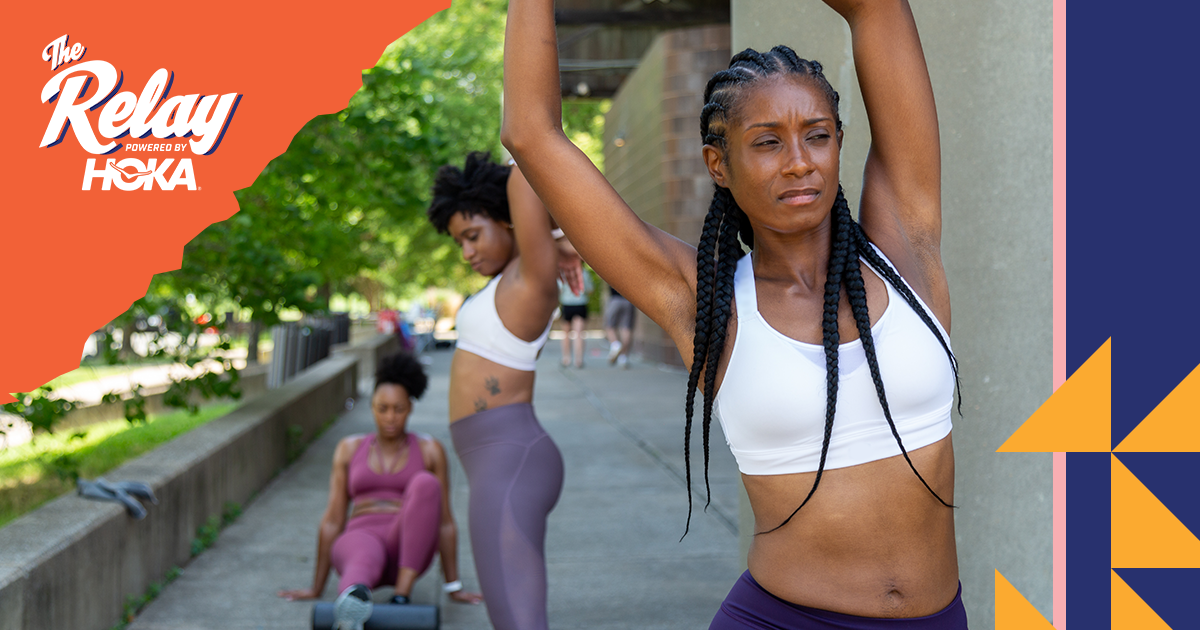The Relay: 5 Ways to Build Running Endurance
Photo: Cortney White/RUNGRL Design
by Marielle Hall, Relay Squad Contributor
When it comes to running, the list of ways to improve performance and endurance can seem never-ending. If you’re like me, you meet this list with enthusiasm for all the ways there are to improve, and confusion on how to incorporate them all.
The key to tackling the task of building endurance is to start with a simple five things, a shortlist of ways to help you get started without feeling intimidated. These five steps can encourage new training journeys or even challenge the seasoned pro.
The Methods of Building Endurance
1. Increase Your Distance Slowly
The key to going farther and faster is staying injury-free. Consistent miles will fuel your endurance and long-term development as an athlete. This means increasing your mileage a little at a time. Focus on staying on your feet, rather than making big jumps in mileage.
For example, in a 10-week distance training block, the first three weeks may stay the same, at 30 miles per week. Weeks 4 and 5 might go up to 35 miles per week, and then up to 38 miles on week 6, and so on. Be careful not to add too many miles at once, and making sure to include a taper or “down week”.
Remember, too, that the long run is a staple of every distance runner’s diet. It challenges your mental toughness, speed and endurance. This run assists in building your aerobic foundation or your “engine”. As your mileage increases, fueling your tank with a weekly run that is about 3-8 miles more than your regular run will help push your endurance forward.
2. Hills, Hills, Hills
Hill running can be tough to break into, but it’s a great way to work the legs, lungs and even the core. Incorporating hills can challenge the entire kinetic chain. This muscle-tendon layer supports all of your bones and ligaments. It is strengthened best through full-body, functional strength workouts that challenge you to move more dynamically, like hills. To get started, try integrating a hilly route into your long run or attempt a structured hill workout.
Sample Hill Workout
30-second Hill Sprint, easy jog back down to the start and repeat 2-4 times
60-second Hill Run, easy jog back down to the start and repeat 2-4 times
90-second Hill Run, easy jog back down to the start and repeat 2-4 times
3. Build Your Mental Running Game
Finding your physical limits will challenge the expectations you have of your body. That’s a good thing! Don’t shy away from the challenge. Setbacks will happen. There will be voices in your head saying you are not meant to go far. Don’t listen. Use affirmations, write down your goals, say them out loud before or during the run, whatever you do, keep going!
One tool I use to stay focused during tough runs is mantras. These power words help to overcome negativity and refocus the mind and body on the task at hand. Draw inspiration from your favorite books, movies, or songs. Keep the phrases simple so you can repeat them with ease when your body is under distress. Here are a few of my favorites:
“This is It!”
“I can. I will.”
“I have to.”
“I love the edge; this is where I want to be.”
4. Check Your Form With Drills
Think of your body as a house. You wouldn’t move furniture into your home without first laying down the foundation. Drills are your running foundation. They isolate parts of your running form so you can address imbalances and challenge movement restrictions. Drills will help your body reinforce strong, sturdy running form for all the miles to come. Start with these:
A-Skips - Skip forward, lifting your lead knee to waist height while keeping your back leg straight as you come off your toe. Continue moving forward in this manner—alternating legs—and striking the ground with your mid-foot or forefoot while swinging your opposite arm in unison with your lead leg.
B-Skips - The first motion is the same as the A-skip. Drive the knee upward the same way, but instead of snapping it back down, extend the leg and bring it back down striking the ground below with the forefoot and kicking back until it’s aligned with the hip. With the B-skip, it should feel like the leg is moving in a circular motion.
Butt Kicks - Bring your knees up in front of you, as if you’re doing a high kick. Bring your foot under your leg so your heel touches your buttocks. Then move forward as you continue this motion. Start slowly and then pick up the pace.
5. Don’t Sleep on Sleep
You don’t build your fitness and endurance by working out hard. Fitness happens when you recover properly and your body absorbs the training. Try getting one extra hour of sleep each night (not just on running days!) and see how much further you can go in the morning.
Which of these steps have you tried? Which do you need to incorporate into your training? Let us know in the comments below!
-
Got questions for our Relay Squad running coaches and athletes? Shoot us a message.
Medical Disclaimer - The above information is not intended as medical advice and does not replace the recommendation of a physician or other medical professional. Always seek the advice of your physician before trying these or any sort of workout or exercise program. View the full medical disclaimer in RUNGRL’s terms of use.
Marielle is a Nike sponsored athlete and member of the Bowerman Track Club, specializing in the 5000M and 10,000M events. She competed in the 10,000M at the 2019 World Championships, the 10,000M finals at the 2016 Olympics in Rio and the 5000M at the 2015 World Championships. At the University of Texas, she became a two-time NCAA All-American in the 5,000M and 10,000M, and won the 5000M title at the 2014 NCAA Outdoor Track & Field Championships.
Marielle is a member of The RELAY Squad. Learn more about The RELAY.













